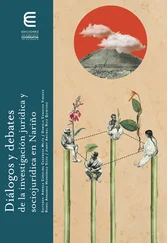The armed conflict has been experienced in a very heterogeneous way throughout the national territory. Rural areas have been more affected than urban areas and some departments have suffered the dynamics of war more than others. Nariño has been one of the territories most affected by violence. Its geographical conditions have made the department a strategic point of the armed conflict. The concurrence of all armed actors in the conflict and the entrenched presence of drug trafficking, combined with the poverty and structural inequalities within the region, configure Nariño as an enclave of extreme vulnerability.
This chapter aims to present a systematic analysis of the antecedents of the armed conflict from a regional perspective, its political, economic and social repercussions, as well as the post-conflict challenges of peacebuilding through a transitional justice process.
The political and agrarian dispute: background to the armed conflict in Colombia
Colombia has seen more than half a century of continuous armed violence, albeit with varying intensity. The longevity of the conflict has also transformed the actors involved, the strategies used and the ways of conducting the war; factors that when combined, directly affect the different degrees and modalities of victimization.
The Colombian war is not exclusively a war of combatants. In its modalities and dynamics, it has been generating what could be defined as a process of outsourcing its impacts, since it has increasingly affected non-belligerent actors; mainly the civilian population. Nor is it a clean war or, at least, it can been disputed under the mandates of International Humanitarian Law. The prolongation and degradation of the violence used by the armed actors broke the ethical and legal limits of the war, exposing one of the characteristic features of the Colombian conflict; the tendency to indiscriminately choose methods and targets.
If we delve into the roots of this problem, a critical reading of the history of Colombia as a nation shows that, since its inception, the country has lived in a permanent state of conflict due –essentially– to two factors; the political power dispute and the control of the land and its natural resources.
Power and political participation
The constant limitations to democracy have been an incentive for the prolongation of the conflict. These are manifested in actions of state power that materialize in restrictive forms of political and citizen participation, protest and dissent, carried out through legitimate and illegitimate measures, as well as under the configuration of long derogation periods that lasted until the expedition of the current Political Constitution of 1991; circumstances that resulted in the decrease of individual rights and freedoms of citizens.
As a consequence of the political power dispute and the traditional competition between the elites, we witnessed the persecution and murder of presidential candidates, the privatization of public corporations, the extermination of social movements, raids, detentions, torture and disappearances, among other crimes committed under the shadow of constant disagreement between liberals and conservatives. But it was not until the murder of the liberal leader Jorge Eliecer Gaitán, in April 1948, when the deepest differences between the two traditional political parties emerged, giving rise to the first guerrilla movements. These were initially sponsored by the liberal party as an armed response to the abuses of the conservative government of Laureano Gómez who, supported by military forces and some ecclesiastical sectors, had implemented a policy of extermination of the opposing party during the historical period known as “La Violencia” or “The Violence”.
However, the desire for power of both parties led to the liberal leaders, having fled the country before the conservative harassment in the toughest stage of La Violencia, making an agreement with Laureano Gómez and his party to form the coalition of the “Frente Nacional” or “National Front” and relieve the de facto president, General Gustavo Rojas Pinilla, from power. And so, a new political period of equitable distribution of power between liberals and conservatives began, replacing the previous efforts and achievements of pacifists, in large part, by social and guerrilla movements.
The guerrilla leaders that survived this period considered the agreed upon terms as a betrayal by the liberal chiefs, so they reoriented their discourse as liberal guerrillas towards Marxist ideas –encouraged, in turn, by the triumph of the Cuban Revolution– and began to nurture the prospect of taking power by force and defeating the government in power. They were especially motivated by their main objective; of ending the pact between liberals and conservatives, which had excluded them from any possibility of political participation within the State.
The dominant concept –from which power was approached, the conflict originated and the insurgency inspired– was based on the binary ideological schemes associated with the context of the East-West conflict, ignoring the diagnoses of the underlying social problems. This was a position shared by both private unions and the Government.
For example:
The military treatment given to the guerrilla movement was the same as that given to social protest, which was criminalized. The issuance of the “Estatuto de Seguridad” or “Security Statute” by the Turbay government, promulgated by Decree 1923 of September 6th, 1978, is proof of this. Through this statute, the military was granted the power to judge the common crimes of civilians, rendering the application of Habeas Corpus useless. (López, 1999, p. 1405).
Concurrent to the strengthening of the insurgency and the escalation of the armed conflict, drug trafficking appeared as a phenomenon that, although not a root cause of the conflict, has been one of the main causes of its intensification and aggravation. Drug trafficking, especially linked to the cultivation of coca and the production and export of cocaine, permeated all the social and political structures of the State. It brought with it almost unlimited resources, which resulted in an expansion and resurgence of the conflict that almost ended the State itself. (Vacas, 2015, p. 80).
Thus, in light of the attacks by different guerrilla groups on drug traffickers, emerald miners and cattle ranchers, particularly, under the government of Ernesto Samper, the go-ahead was given for the creation of the Convivir, Rural Security Cooperatives of a private nature in charge of informing agents of the State on the presence of guerrillas. These cooperatives eventually became the “Autodefensas Unidas de Colombia” or “United Self-Defense Forces of Colombia”, a paramilitary organization that, with the support of the “lords and landowners” was constituted as the largest criminal structure that ever existed in the country, turning the nineties and part of the new century into one of the most bloodthirsty and violent periods in Colombia’s history.
Both guerrillas and paramilitaries have instrumentalized the institutions and mechanisms of democracy according to their interests; not only the elections, but also the spaces for social participation, protest and social movements, such as community boards or unions. Both have violently punished the gestures of autonomy made by communities and social leaders. Democracy has been seen by all armed actors as both a positioning opportunity and, in turn, a threat to their war plans. Thus, the different forms of struggle have been combined, dangerously mixing war and politics. Therefore, from this perspective, the great victim of this conflict has been democracy itself (Centro Nacional de Memoria Histórica, 2013, p. 52).
Armed conflict and land control
Читать дальше












